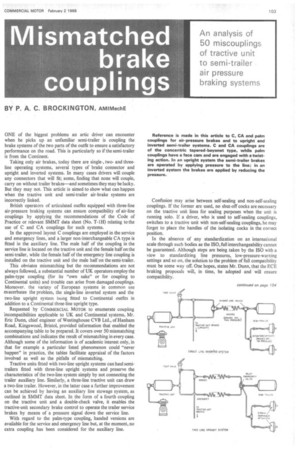BY P. A. C. BROCKINGTON, AMIMechE
Page 105

If you've noticed an error in this article please click here to report it so we can fix it.
ONE of the biggest problems an attic driver can encounter when he picks up an unfamiliar semi-trailer is coupling the brake systems of the two parts of the outfit to ensure a satisfactory performance on the road. This is particularly so if the semi-trailer is from the Continent.
Taking only air brakes, today there are single-, twoand threeline operating systems, several types of brake connector and upright and inverted systems. In many cases drivers will couple any connectors that will fit; some, finding that none will couple, carry on without trailer brakes—and sometimes they may be lucky. But they may not. This article is aimed to show what can happen when the tractive unit and semi-trailer air-brake systems are incorrectly linked.
British operators of articulated outfits equipped with three-line air-pressure braking systems can ensure compatibility of air-line couplings by applying the recommendations of the Code of Practice or relevant SMMT data sheet (No. T-1H) relating to the use of C and CA couplings for such systems.
In the approved layout C couplings are employed in the service and emergency lines, and a larger non-interchangeable CA type is fitted in the auxiliary line. The male half of the coupling in the service line is located on the tractive unit and the female half on the semi-trailer, while the female half of the emergency line coupling is installed on the tractive unit and the male half on the semi-trailer.
This obviates mismatching but the recommendations are not always followed, a substantial number of UK operators employ the palm-type coupling (for its "own sake" or for coupling to Continental units) and trouble can arise from damaged couplings. Moreover, the variety of European systems in common use exacerbates the problem, the single-line inverted system and the two-line upright system being fitted to Continental outfits in addition to a Continental three-line upright type.
Requested by COmmEROAL MOTOR to enumerate coupling incompatibilities applicable to UK and Continental systems, Mr. Eric Dunn, chief engineer of Westinghouse CVB Ltd., of Hanham Road, Kingswood, Bristol, provided information that enabled the accompanying table to be prepared. It covers over 50 mismatching combinations and indicates the result of mismatching in every case. Although some of the information is of academic interest only, in that for example a particular listed phenomenon could "never happen" in practice, the tables facilitate appraisal of the factors involved as well as the pitfalls of mismatching.
Tractive units fitted with two-line upright systems can haul semitrailers fitted with three-line upright systems and preserve the characteristics of the two-line system simply by not connecting the trailer auxiliary line. Similarly, a three-line tractive unit can draw a two-line trailer. However, in the latter case a further improvement can be achieved by having an auxiliary line stowage system, as outlined in SMMT data sheet. In the form of a fourth coupling on the tractive unit and a double-check valve, it enables the tractive-unit secondary brake control to operate the trailer service brakes by means of a pressure signal down the service line.
With regard to the palm-type coupling, handed versions are available for the service and emergency line but, at the moment, no extra coupling has been considered for the auxiliary line.
Confusion may arise between self-sealing and non-self-sealing couplings. If the former are used, no shut-off cocks are necessary on the tractive unit lines for sealing purposes when the unit is running solo. If a driver, who is used to self-sealing couplings, switches to a tractive unit with non-self-sealing couplings, he may forget to place the handles of the isolating cocks in the correct position.
In the absence of any standardization on an international scale through such bodies as the ISO,full interchangeability cannot be guaranteed. Although steps are being taken by the ISO with a view to standardizing line pressures, low-pressure-warning settings and so on, the solution to the problem of full compatibility must be some way off. One hopes, states Mr. Dunn, that the ECE braking proposals will, in time, be adopted and will ensure compatibility.




































































































































































































